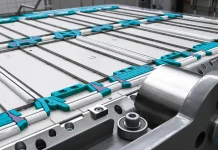By Mark Porter, president, Dienamic Software
Businesses constantly are trying to increase profits by developing new products they can offer to existing customers and finding different ways to attract new customers. But, this only is one side of the profit equation. Profit is sales minus costs, so business owners can improve profits by focusing on controlling costs as well. Software and technology are excellent ways to control the cost component and therefore maximize profits.
Remote access of the front office tasks – such as estimating, order entry, purchasing/receiving, shipping and invoicing – facilitates a constant and consistent flow of information from customers to plant staff to ensure the work coming into the plant runs smoothly and on time. Communication between the office and the plant is in real time and accurate to ensure good jobs do not go bad. Unfortunately, the latest business environment has shown the extra importance of having a remote capability in shop operations. The ability to manage jobs remotely can be a tremendous advantage in current times.
Improving costs on the shop floor can be achieved in many ways with software and technology.
Controlling costs in the plant starts in the office
As a job-oriented manufacturing business, Dienamic is constantly estimating potential jobs in hopes that it wins a percentage of those jobs. It is vital that the process of bringing jobs into the plant accurately reflects the cost of producing the job. Software can help with this. Estimating software must reflect the true cost of resources in the plant and represent their true speed and makeready capabilities.
If a press is estimated at producing 5,000 sheets per hour but only is achieving 3,000 sheets per hour on the shop floor, the business is losing money on every job won. Conversely, if the company is quoting at 3,000 sheets per hour and achieving 5,000 sheets per hour on the shop floor, it is losing jobs it could be producing profitably. Software will allow businesses to track their production statistics and show the average speeds and makeready times actually being achieved on the shop floor.
Most business owners are aware of machine speeds and makereadies, but the true cost of having the equipment on their plant floor is not well known. The cost is based on cost of machine, rent, employee wages and benefits, factory overheads, number of shifts and percentage productivity. Again, ensuring the estimating system reflects the true costs of the equipment on the shop floor is vital. There is budgeted hourly rate software that can help with getting accurate machine hourly costs.
Communication increases productivity and decreases waste
Technology allows for storing and organizing a great deal of information and for distributing that information instantly. By distributing job information, customer information, material information and previous problem information, it is possible to reduce mistakes, improve deliveries and provide better customer service.
Features such as Electronic Orders allow changes from a customer to be communicated to the plant employees the second the change is made on the order. This avoids the cost of mistakes resulting from the plant working with out of date information. It also cuts down on information delay that can lead to extra costs.
Customer Profiling allows companies to record all the ways their customers like to have their jobs produced – things like number of overs (excess product), shipping details, sample requirements and communications procedures. Gathering this information and distributing it to plant employees ensures jobs are produced to the customer’s exact specifications. This reduces errors and makes for happier customers. For example, take the shipping employee who has a job with 11,000 finished pieces but the order only calls for 10,000. The shipping clerk can look at the customer’s profile, which shows the company will accept 5% overs. 10,500 are shipped, maximizing revenue while holding 500 back that may be sold later.
Purchasing modules allows for tracking the purchase orders issued and comparing the goods received to the goods for which the vendor invoices. It also compares the cost agreed to on the purchase order to the invoice the vendor sends. Catching any of these discrepancies can provide tremendous cost savings.
Job Notes can be added to electronic orders and can be accessed by the plant employees on the shop floor. If there are specific instructions for a job that are designated by the order entry staff, they can be displayed to the plant employee at any time. For example, if the job is run on the afternoon shift at 7:00 p.m. the notes are printed out and available to the plant employee to ensure the job is run correctly.
It also is possible to track problems and machine setups for previous jobs. For many shops, a certain percentage of jobs produced are reruns of previous jobs. By recording problems and machine settings for a job, shops are in a much better position to produce the job a second time in a more productive and less costly manner than the first. This also is useful for estimating and order entry. When requoting a job, businesses can account for any mistakes experienced the first time. They then can adjust the estimate and write up the order based on those initial experiences. Reduction of costs on the shop floor starts at estimating.
Software allows businesses to track all materials that enter the shop floor. This includes printing sent by customers and supplies needed to produce jobs sent by vendors. Staying on top of goods that enter the plant ensures that jobs are produced on time. Overtime and pulling other jobs off equipment to meet deadlines can be avoided while eliminating additional shipping costs incurred to get missed items to the plant on time.
Furthermore, many finishers and binders have a large inventory of dies. Software that manages die inventory can save money. Knowing where dies are stored and if they have been disposed of or sent back to the customer can save the cost of looking for dies or remaking them. Knowing if a die needs retooling before the job arrives can avoid the costs of press downtime or missed deadlines.
By increasing communications, software can reduce costs associated with missed information and the costs associated with the inefficiencies of employees having to ask other employees or customers questions. Software automatically can create emails that are sent between managers, employees and customers when changes occur. Once a job is opened or changed, an email is generated and sent to the people who most need the information. This also happens when a purchase order is generated, goods are received, packing slips and invoices are generated, and dies need retooling.
Chargeable changes are costs that someone has to pay
Everyone has those jobs that start as one thing and quickly morph into something completely different. As a result, the original estimate of the cost of that job is out the window. Those changes must be paid for by someone, and too often it is the finisher/binder.
Software can, at the very least, track these costs so they can be recovered from the customer; however, businesses should be making a profit on these services. Customer change management software allows users to open an order, and if/when any changes are made to the order, these changes are date-/time-/employee-/cost- and reason-stamped, providing documentation of communications with the customers as to changes made and costs incurred. At the end of the job, management can get a complete listing of all changes and the dates/times of notifications. By documenting changes, businesses can capture legitimate extra charges without damaging the relationship with the customer.
Labor and production analysis
Labor and machine time are by far the biggest cost to the print finishing industry. Tracking the way employees and equipment are utilized can provide tremendous insight into the biggest cost components. The use of software and biometric (fingerprint) technology allows businesses to track every minute of every employee and machine in the company. An employee’s chargeable vs. non-chargeable time can be analyzed. If employees are performing less than 70% chargeable tasks, managers can evaluate his/her role. It also is possible to analyze time spent running, makereading, repairing and maintaining equipment, as well as determine how much time is spent waiting for approvals, etc.
The software also analyzes the average speeds and times of makereadies and running processes, and it further analyzes how individual employees are doing in relation to those machine standards. This information allows businesses to ensure their estimating accurately reflects the costs in their plant.
Conclusion
Automating facilities with the proper software and technology can save tens of thousands of dollars by helping businesses know true costs, in addition to helping properly manage employees and production time.
Mark Porter is president of Dienamic Software and can be reached at 1.800.461.8114, mark@dienamicmis.com or www.dienamicmis.com.





